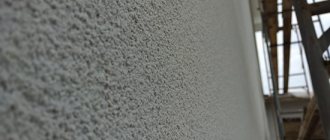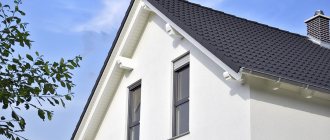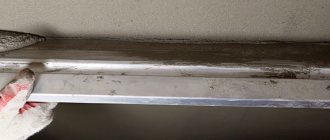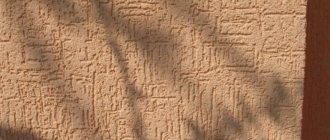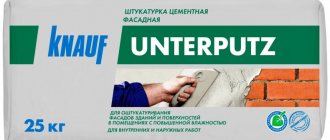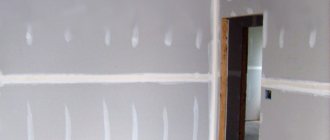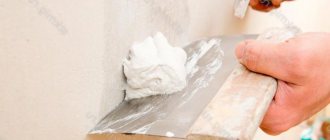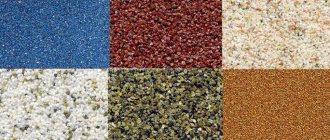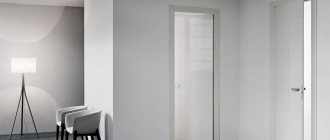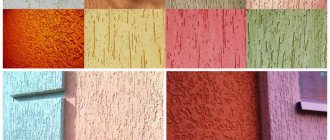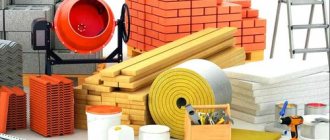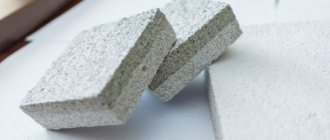Facade decorative plaster has properties that prevent external influences, and also add decorativeness to the facade along with protecting the walls.
The modern market is rich in high-tech facade plastering products: these include facade plaster from various manufacturers, including Ceresit mixture.
This manufacturer meets all the requirements for façade coating. Ceresit is represented by a company that has been producing products for construction and finishing for decades.
What is decorative plaster Ceresit (Ceresit)
Decorative plaster Ceresit is a multi-layer finishing coating that allows you to give the surface a certain texture. The latter directly depends on the type of material, the tools used and the method of application.
This mixture can be used for decorative finishing of flooring, walls and building facades. With the help of appropriate dyes it can be painted in any shade.
Decorative plaster Ceresit is one of the world's leading brands. These products are presented on the Russian market.
In the countries of Eastern and Central Europe, Ceresit occupies one of the leading positions, and in Russia it is one of the three leading Western brands with local production of cement mixtures.
The decorative plaster of this manufacturer is distinguished not only by its outstanding quality, but also by a wide variety of assortments. The company produces mixtures for both interior and exterior use.
Read technologies for applying decorative plaster from Bark Beetle here.
Preparing the base
The so-called wet façade Ceresit before the device involves preliminary preparation of the surface:
- The previous facade cladding, if present, is assessed for stability and the degree of its adhesion to the walls and, if necessary, is removed.
- If necessary, the surfaces are leveled. For this purpose, façade putty Ceresit ST 29 is used, applied to walls pre-treated with the primer composition Ceresit ST 17.
- Next, on the border between the base and the main facade, a base profile is installed along the entire perimeter of the building.
Facade putty Ceresit for leveling facade walls
Tips for choosing
Today there are many varieties and modifications of decorative plaster. The first thing you need to decide is whether to buy a dry solution or a ready-made mixture.
Dry
Dry mixtures are much cheaper. However, there is a risk of mixing the solution in the wrong proportion, which will simply ruin the coating. Dry materials are packaged in paper bags. They cannot be stored for a long time in a humid environment. Ready-made options are produced in plastic containers.
Dry plaster can be stored for a maximum of 6 months, ready-made - 2 years, and does not require any special conditions.
Drying time also varies. So dry plaster dries up to 28 days, ready-made – 7. Speaking of colors, dry plaster is often produced in white or pastel colors. To give the coating the desired shade, you need to add either a special dye or cover the surface with silicone paint. Both need to be purchased additionally. In the case of a ready-made mixture, such difficulties will not arise. Depending on the composition, decorative plasters can be divided into mineral, acrylic and silicate.
How to paint wallpaper for painting?
Mineral
Mineral ones are best suited for exterior decoration. This is the most affordable option. However, in terms of its heat and moisture-conducting properties, it is inferior to other types, moreover, it requires a more even base.
Acrylic or silicone
Acrylic and silicate mixtures are more elastic and reliable. They do not allow moisture to pass through, do not crack, and help hide minor surface defects. They can be used in any room, however, their cost is appropriate.
How to properly prepare the mixture
To prepare the mixture, you must have a container (bucket) for mixing it (use only stainless steel utensils). The manufacturer most often produces plaster in 25 kg bags.
To correctly calculate the required amount of mixture, it should be taken into account that the recommended mixture consumption per 1 m² is from 2.5 kg to 4 kg.
For 5-6 liters of water you need to add 25 kg (bag) of dry composition. Cold water must be used.
The plaster should be mixed with a mixer or concrete mixer.
The mixture is left for three minutes to completely dissolve, and then it should be mixed again.
IMPORTANT!
The prepared mixture should be used within three hours.
The frozen mixture cannot be used.
Varieties and characteristics
Today the company produces the following types of decorative plaster:
- Cerecit Decor Plus. The material is sold in the form of a dry mixture, suitable for use both inside and outside the building. It has high vapor and thermal insulation and impact resistance, and is not affected by moisture and temperatures. This plaster can be used on concrete, gypsum, cement, cement-lime, plasterboard, wood and other substrates. Depending on the method of use, the plaster can have the following textures: bark beetle (pronounced grooves), fur coat (embossed), pebble (coarse-grained). The resulting textured surface can be painted with silicone, silicate or acrylic paints.
Glass mosaic for kitchen backsplash: what is it?
- Ceresit CT 137 (mineral). This is a coarse-grained impact-resistant material. Produced in dry form, it is highly resistant to moisture, steam and temperature changes. This type of plaster has two variations - white and paintable. It can be used both inside and outside the building. It can be applied either mechanically or manually to almost any surface. It is recommended to be used for thermal insulation systems of facades with polystyrene foam and mineral wool boards. There is also a winter version of the mixture, which can be used at temperatures from 0 degrees.
- Ceresit CT 72/CT 73 (silicate). This variety is produced in the form of a ready-made solution and can be painted. This plaster has two types of texture - pebble and bark beetle. It is resistant to ultraviolet radiation, temperature changes, moisture, steam, mold and mildew, and is suitable for both interior and exterior decoration. Most often this material is used for interior decoration.
Seamless ceiling tiles: a cheap alternative to suspended ceilings.
- Ceresit CT 77 (acrylic). This type of plaster is also available in the form of an already diluted mixture. It has 48 colors and is resistant to abrasion, dirt and temperature changes. This material can be used for both design and facade work. It has a granular structure of multi-colored marble or quartz chips.
- Ceresit CT 35 (mineral). The material is produced in the form of a dry mixture and has two variations - white and paintable. The grain size also varies. The material can be used on any surfaces inside and outside the building. Can be used for thermal insulation systems. The plaster also has a winter version, suitable for use in the cold season. Available textures – bark beetle.
The use of modular sofa systems in small apartments.
- Ceresit CT 60/CT 64 (acrylic). Available in the form of a ready-made mixture. The material has pebble and bark beetle textures. This plaster is highly resistant to moisture and temperature changes, it is quite elastic and resistant to deformation, and is suitable for interior and exterior work. This material forms a durable elastic coating that can hide small cracks and surface defects, which is important for areas with high humidity. The plaster can be painted in any desired shade.
- Ceresit CT 74/CT 75 (silicone). This variety is produced in the form of a ready-made mixture, has high heat and water insulation, and is easy to clean. This material creates a durable, elastic coating that can hide small cracks and crevices. It is not susceptible to contamination and is able to maintain its original appearance for a long time. The plaster has pebble and bark beetle textures and is suitable for painting.
- Ceresit CT 175/CT 175 (silicate-silicone). Produced in the form of a ready-made mixture, it is resistant to moisture, ultraviolet radiation, temperature changes, the formation of fungi and mold, and can be used inside and outside the building. This material has pebble and bark beetle textures.
Advantages
- Resistant to fungi, algae (patented BioProtect formula).
- Resistant to dirt (self-cleaning).
- Excellent steam permeability (the surface “breathes”): vapor permeability coefficient ≥ 0.035 mg/(m⋅h⋅Pa), class 2.
- High degree of elasticity.
- Resistance to mechanical stress (impact resistance index ≥ 7 J).
- Low flammability (flammability group G1).
- Retains original color.
- Durable.
- Suitable for mechanical application.
- Has low water absorption: ≤ 15%, water absorption coefficient ≤ 0.1 kg/(m 2 hour 0.5).
- Wide selection of shades.
Laying
The appearance of the finished surface directly depends on the method of applying decorative plaster.
Before starting to work with plaster mortar, you need to prepare the surface. Textured putty, unlike many other materials, does not require a perfectly flat surface and masks all defects well. So before applying you need:
- Clean the base from any remnants of the previous coating. There should be no oil or grease stains on it. After this, the surface should be treated with a weak soap solution and coated with a primer.
- If there are large cracks, they should be expanded and filled with a cement or gypsum-based composition. For these purposes, putty is used.
- Prime the wall again.
The base must be stronger than the textured coating.
Before directly applying the plaster, it should be tested on a small area. This allows you to determine the optimal concentration of material in the case of dry plaster mixtures. When applying the material, it is best to work with a partner. So one applies the mixture, and the second creates the desired texture. If there is no partner, then you will have to work in several stages, because... the material dries quickly and the texture should be created immediately after application. The mixture is applied to the walls using a spatula. Its optimal thickness is 2-3 mm.
The optimal thickness of coarse plaster is equal to the grain size.
Next, let's look at some of the most popular textures:
- Bark beetle To create it, you need to lay the plaster using a spatula or steel float. The surface on which the solution is applied should not exceed 1.5 square meters. m. The material must be evenly distributed over the surface. After 20 minutes, when the mixture stops sticking to the tools, you need to apply the design using a plastic or wooden trowel. The grater should move smoothly, without unnecessary effort, parallel to the floor.
- Pebble. To create such a relief, apply a small layer of solution using a trowel and let it dry. When the solution dries sufficiently, it must be treated with the same trowel. The latter must be kept parallel to the plane being decorated. The texture should be formed with jerky circular movements, without excessive pressure. All movements should be as light as possible and directed strictly clockwise or counterclockwise. The working surface should be constantly cleaned of excess mixture.
- Mosaic. To obtain a similar texture, you need to apply the material to the surface using a stainless steel grater. The grater should be held at an angle of 60 degrees. The thickness of the applied solution should not exceed 1.5 grain sizes. After 15-20 minutes, use the same grater to smooth the surface to be treated.
Fastening thermal insulation boards
Using the Ceresit complex, the facade insulation system must be installed in accordance with the following rules:
- To attach thermal insulation, which is usually polystyrene foam or mineral wool boards, adhesive mixtures Ceresit ST 85 and ST 190 are used, as well as polyurethane adhesive ST 84 in cylinders (see insulation for ventilated facades).
- On polystyrene foam boards, the adhesive mixture is applied in a strip 6 cm wide and 2 cm high along the perimeter of the surface with a distance of 2 cm from the edges. In the center of the board, the solution is applied in the form of beacons 10 cm in diameter and 2 cm high in the amount of 5-8 pieces.
- The solution is applied in a continuous layer to the mineral wool slabs.
- After applying the Ceresit adhesive mixture, the slab must be immediately applied to the wall and pressed.
- The slabs are fastened from the base profile in a row from the bottom up, controlling in the process the degree of verticality of the resulting plane.
- After the insulation of the Ceresit facades has been completed and the adhesive mixture has dried, the surface of the insulation boards is sanded using a polisher and coarse sandpaper.
- Next, the slabs are additionally attached to the facade using dowels with wide heads.
Bonding polystyrene foam boards using Ceresit adhesive mixture
Price
The cost of Ceresit decorative plaster can vary within the following limits (price for 1 package):
- Cerecit Dekor Plus – 380-428 rub.
- Ceresit CT 137 – 774-1000
- Ceresit CT 72/CT 73 – 3800-6000
- Ceresit CT 77 – 2800-3800 rub.
- CT 35 – 650-750 rub.
- CT 60/CT 64 – 1400-1800 rub.
- Ceresit CT 74/CT 75 – 3500-4500 rub.
- Ceresit CT 175/CT 175 – 2000-2200 rub.
You can purchase any type of solution in one of the official distributor stores - their names, addresses in the regions and opening hours are indicated on the manufacturer’s official website.
FOREST – green palette
Harmony and balance, the element of the plant kingdom, a symbol of calm, peace, unconditional love. This is the green color in all the variety of shades of the Ceresit collection. The creation of which was inspired by the green riot of landscapes of Montana, the slopes of Tuscany, the impenetrable forests of Java and other colorful corners of the world. Whatever tone of green you choose to decorate your home - dark or light, rich or muted, restrained or outrageous - it will emphasize your attitude towards the world, towards yourself, life opportunities and prosperity. The choice is always yours!
Customer Reviews
Vladimir Kuznetsov
I used decorative plaster Ceresit CT 137 to decorate the hallway at the dacha. This was my first time working with this material. When applied, the plaster does not form into lumps and does not flow. Overall the material is decent. As for texture, creating a pattern is relatively simple. True, it still hardens a little longer than stated on the packaging.
Leonid Vengrin
I have known this brand for quite a long time. When insulating a house, Ceresit was one of the first to provide plasters for finishing. I used ST 35 mineral decorative plaster. On the website, everything was clearly described on how to prepare the mixture, apply it, and add texture. It has lasted for three years now, does not peel off, does not crack. Overall satisfied.
EARTH – a palette of brown, orange, pink
This color group is the richest. It has absorbed all the variety of earth tones - from rich brick red to soft pink and deep orange. The collection was inspired by amazing places on the planet: Andolusia and Umbria with picturesque brown mountain peaks, Arizona with reddish stone plateaus and endless deserts of pink sand, Calabria with rocky brown-orange shores, etc. The range of natural earth tones symbolizes naturalness, organicity, reliability, and respect for traditions and love for the world. There is plenty to choose from in the Ceresit collection: dark and medium shades of brown, rich and muted, with different undertones (gray, orange, gold, green, red, purple). What do you choose?
